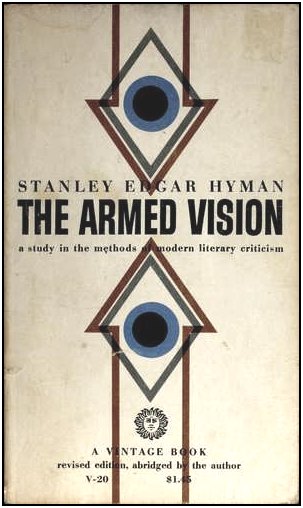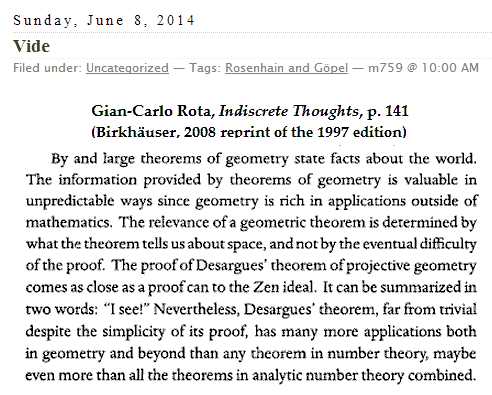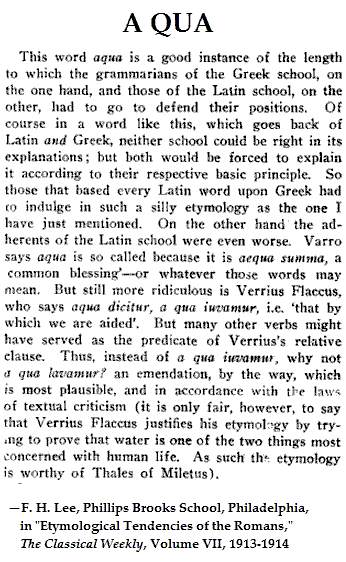Thursday, July 31, 2014
The title phrase (not to be confused with the film 'The Zero Theorem')
means, according to the Encyclopedia of Mathematics,
a null system , and
"A null system is also called null polarity,
a symplectic polarity or a symplectic correlation….
it is a polarity such that every point lies in its own
polar hyperplane."
See Reinhold Baer, "Null Systems in Projective Space,"
Bulletin of the American Mathematical Society, Vol. 51
(1945), pp. 903-906.
An example in PG(3,2), the projective 3-space over the
two-element Galois field GF(2):

See also the 10 AM ET post of Sunday, June 8, 2014, on this topic.
Comments Off on Zero System
Wednesday, July 30, 2014
Comments Off on Photo Opportunities
Comments Off on Ready for My Closeup
Tuesday, July 29, 2014

See also Aqua in this journal.
Comments Off on New Art Now
See “Charles Williams” + Witchcraft in this journal.
Williams was one of the Inklings, a group of Christian
writers that included C. S. Lewis and J. R. R. Tolkien.
Comments Off on The Craft

See also Kurtz in this journal.
Comments Off on Darkness at Noon

In memoriam :
“Margot Adler, an iconic NPR correspondent and Wiccan priestess,
died on Monday July 28 from endometrial cancer at the age of 68.”
— Huffington Post 07/28/2014 5:39 pm EDT
See also Log24 posts tagged NPR Magic.


Comments Off on Radio Days
Two items from this morning’s news:


“Sasaki Roshi trained for years in a distinctively strict style of Zen
that he transplanted to the U.S. His students rose at 3 a.m.
for chanting, exhausting hours of meditation and one-on-one
meetings with their teacher, who would pose impenetrable
koans, riddles like: ‘When you see the flower, where is God?'”
For a mathematician’s example of an alleged Zen ideal, see the feast day
this year of St. Gerard Manley Hopkins.
Comments Off on Strict Form
Monday, July 28, 2014
Wikipedia article:
Reductionism is a philosophical position
which holds that a complex system is nothing but
the sum of its parts, and that an account of it can be
reduced to accounts of individual constituents.[1]
1. See e.g. Reductionism in the Interdisciplinary
Encyclopedia of Religion and Science.
“The Website of the Interdisciplinary Encyclopedia on
Religion and Science is edited by the Advanced School
for Interdisciplinary Research (ADSIR), operating at the
Pontifical University of the Holy Cross, Rome….”
For a reductionist Holy Cross, see yesterday’s noon post.
Comments Off on Reductio Ad
Sunday, July 27, 2014
George Johnson, a science writer, in The New York Times
on July 21, 2014:
“New particles may yet be discovered, and even new laws.
But it is almost taken for granted that everything
from physics to biology, including the mind,
ultimately comes down to four fundamental concepts:
matter and energy interacting in an arena of space and time.”
Related material:

Ite, missa est.
Comments Off on George Johnson’s Theory of Everything
Saturday, July 26, 2014
Or: Two Rivets Short of a Paradigm
Detail from an author photo:

|
From rivet-rivet.net:
The philosopher Graham Harman is invested in re-thinking the autonomy of objects and is part of a movement called Object-Oriented-Philosophy (OOP). Harman wants to question the authority of the human being at the center of philosophy to allow the insertion of the inanimate into the equation. With the aim of proposing a philosophy of objects themselves, Harman puts the philosophies of Bruno Latour and Martin Heidegger in dialogue. Along these lines, Harman proposes an unconventional reading of the tool-being analysis made by Heidegger. For Harman, the term tool does not refer only to human-invented tools such as hammers or screwdrivers, but to any kind of being or thing such as a stone, dog or even a human. Further, he uses the terms objects, beings, tools and things, interchangeably, placing all on the same ontological footing. In short, there is no “outside world.”
Harman distinguishes two characteristics of the tool-being: invisibility and totality. Invisibility means that an object is not simply used but is: “[an object] form(s) a cosmic infrastructure of artificial and natural and perhaps supernatural forces, power by which our last action is besieged.” For instance, nails, wooden boards and plumbing tubes do their work to keep a house “running” silently (invisibly) without being viewed or noticed. Totality means that objects do not operate alone but always in relation to other objects–the smallest nail can, for example, not be disconnected from wooden boards, the plumbing tubes or from the cement. Depending on the point of view of each entity (nail, tube, etc.) a different reality will emerge within the house. For Harman, “to refer to an object as a tool-being is not to say that it is brutally exploited as a means to an end, but only that it is torn apart by the universal duel between the silent execution of an object’s reality and the glistening aura of its tangible surface.”
— From "The Action of Things," an M.A. thesis at the Center for Curatorial Studies, Bard College, by Manuela Moscoso, May 2011, edited by Sarah Demeuse
|
From Wikipedia, a programming paradigm:

See also posts tagged Turing's Cathedral, and Alley Oop (Feb. 11, 2003).
Comments Off on OOPs
Friday, July 25, 2014
In honor of Ace Greenberg, a major Wall Street player
who reportedly died today at 86:

See also this journal on the date of the above review,
March 9, 2009: First and Last Things.
Comments Off on Review
This post was suggested by…


“Oh, the humanity!” — Reporter’s comment
Comments Off on Zeppelin Concert
“It’s going to be accomplished in steps,
this establishment of the Talented
in the scheme of things.”
— Anne McCaffrey, Radcliffe ’47, To Ride Pegasus
From a review of the new film “Magic in the Moonlight”—
“Sophie seems to have some actual talent….
When Sophie meets Aunt Vanessa, she uncovers the spinster’s
long-ago love affair with a member of parliament. It’s eerie.”
Material that is related, if only in story space:
Comments Off on Actual Talent
Comments Off on Magic for Jews
“Just a lying rhyme for seven!” — Playwright Tom Stoppard on Heaven

Related material in this journal: Lying Rhyme and Happy Birthday.
Comments Off on Lying Rhyme?
“The yarns of seamen have a direct simplicity, the whole meaning
of which lies within the shell of a cracked nut. But Marlow was not
typical (if his propensity to spin yarns be excepted), and to him the
meaning of an episode was not inside like a kernel but outside,
enveloping the tale which brought it out only as a glow brings out a
haze, in the likeness of one of these misty halos that sometimes
are made visible by the spectral illumination of moonshine.”
— Joseph Conrad in Heart of Darkness
“By groping toward the light we are made to realize
how deep the darkness is around us.”
— Arthur Koestler, The Call Girls: A Tragi-Comedy,
Random House, 1973, page 118
“Spectral evidence is a form of evidence
based upon dreams and visions.” —Wikipedia

See also Moonshine (May 15, 2014) and, from the date of the above
New York Times item, two posts tagged Wunderkammer .
Related material: From the Spectrum program of the Mathematical
Association of America, some non-spectral evidence.
Comments Off on Magic in the Moonshine
Thursday, July 24, 2014
Comments Off on Death in Mathmagic Land
Wednesday, July 23, 2014
"Lord knows when the cold wind blows
it'll turn your head around."
— James Taylor, "Fire and Rain"

Ricky Jay's head turns around in "The Amazing Maleeni,"
episode 8 of season 7 of "The X-Files."
"It was the middle of summer, but
the cold wind blew in full force."
— David Kushner, Jonny Magic and the Card Shark Kids
(Quoted here in House of Cards, June 11, 2014,
a post on magic, cards, and Multnomah County.)
Related material:
Recent posts on artist Otto Piene and the Whiskey Bar song,
as well as the following Multnomah County story from yesterday's
online NY Times :

Comments Off on Cold Wind
This is a post in memory of artist Otto Piene, who reportedly died
at 86 on Thursday, July 17, 2014, in Berlin.

*For the title, see Alternate Reality, a post of Saturday, July 19, 2014.
See also Piene and paradigms, and Paradigm Shift from the date of death
for Piene and Hartsfield.
Comments Off on Sky Captain*
Tuesday, July 22, 2014
Monday, July 21, 2014

Click on the above video for a theological remark by Clint Eastwood.
Comments Off on Space-Cowboy Theology
Sunday, July 20, 2014
“Tell it slant.” — Emily Dickinson


Comments Off on Sermon
Paradigms of Geometry:
Continuous and Discrete
The discovery of the incommensurability of a square’s
side with its diagonal contrasted a well-known discrete
length (the side) with a new continuous length (the diagonal).
The figures below illustrate a shift in the other direction.
The essential structure of the continuous configuration at
left is embodied in the discrete unit cells of the square at right.

See Desargues via Galois (August 6, 2013).
Comments Off on Sunday School
Saturday, July 19, 2014


From the date of Piene's death —

See also Zero Theorem in this journal.
Comments Off on More or Less by Chance
“Zero is a group of artists founded by Heinz Mack and
Otto Piene….” — Wikipedia
“The title ZERO was the result of months of search
and was finally found more or less by chance.
From the beginning we looked upon the term
not as an expression of nihilism – or a dada-like gag,
but as a word indicating a zone of silence and of
pure possibilities for a new beginning as at the
count-down when rockets take off- zero is the
incommensurable zone in which the old state turns
into the new.”
— Otto Piene, 1964
Comments Off on Zero Art
(Where Entertainment Is God , continued)
In memory of artist Otto Piene — a news item from last May
at the ZERO Foundation website on an exhibition that closes tomorrow —
2014-05-15
Today is the opening of the exhibition ZERO — Zwischen Himmel und Erde
in Friedrichshafen. The Zeppelin Museum is showing wonderful artworks
all related to heaven and earth by various ZERO artists
such as Piene, Mack, Uecker, Klein, Luther, and Manzoni.
ZERO – Zwischen Himmel und Erde
Zeppelin Museum Friedrichshafen
15.05. – 20.07.2014
www.zeppelin-museum.de
“Oh, show me the way to the next whiskey bar”
— Song lyric from previous post

“In a technologically advanced 1939, the zeppelin Hindenburg III
arrives in New York City, mooring atop the Empire State Building.”
— Wikipedia on the first scene of the 2004 film
“Sky Captain and the World of Tomorrow“
Comments Off on Alternate Reality
Friday, July 18, 2014
From The Thin White Duke:
“When I was living in my apartment in Berlin,
I would sing this at breakfast every morning.”
Oh, show me the way to the next whiskey bar
Oh, don’t ask why, no, don’t ask why
For we must find the next whiskey bar
Or if we don’t find the next whiskey bar
I tell you we must die, I tell you we must die
I tell you, I tell you, I tell you we must die
Read more: David Bowie – Alabama Song Lyrics | MetroLyrics
See also…

“Wir trauern um Otto Piene, der unerwartet am 17.7 in Berlin gestorben ist.”
Comments Off on Breakfast Song
The Los Angeles Times on entertainer Elaine Stritch,
who died yesterday (Thursday, July 17, 2014):
“She made few apologies in her career, describing herself as
a ‘Catholic, diabetic, alcoholic, pain in the ass.'” — David Ng
“Band of angels, lead me home.” — Song lyric

Detail:


Scene from 3:10 to Yuma (1957)
Related material:


Comments Off on In Memoriam
Thursday, July 17, 2014
Continuous Euclidean space to discrete Galois space*
Euclidean space:

From a page by Bryan Clair
Counting symmetries in Euclidean space:

Galois space:

Counting symmetries of Galois space:

The reason for these graphic symmetries in affine Galois space —
symmetries of the underlying projective Galois space:

* For related remarks, see posts of May 26-28, 2012.
Comments Off on Paradigm Shift:
Wednesday, July 16, 2014
Comments Off on Christmas Ornaments
(Continued from a private post of May 27, 2012)

Comments Off on Finite Jest
The title is taken from a post of July 11.



Comments Off on Math Guy
Tuesday, July 15, 2014
"I need a photo opportunity, I want a shot at redemption.
Don't want to end up a cartoon in a cartoon graveyard."
– Paul Simon

|
"The theory of poetry, that is to say, the total of the theories of poetry, often seems to become in time a mystical theology or, more simply, a mystique. The reason for this must by now be clear. The reason is the same reason why the pictures in a museum of modern art often seem to become in time a mystical aesthetic, a prodigious search of appearance, as if to find a way of saying and of establishing that all things, whether below or above appearance, are one and that it is only through reality, in which they are reflected or, it may be, joined together, that we can reach them. Under such stress, reality changes from substance to subtlety, a subtlety in which it was natural for Cézanne to say: 'I see planes bestriding each other and sometimes straight lines seem to me to fall' or 'Planes in color…. The colored area where shimmer the souls of the planes, in the blaze of the kindled prism, the meeting of planes in the sunlight.' The conversion of our Lumpenwelt went far beyond this. It was from the point of view of another subtlety that Klee could write: 'But he is one chosen that today comes near to the secret places where original law fosters all evolution. And what artist would not establish himself there where the organic center of all movement in time and space– which he calls the mind or heart of creation– determines every function.' Conceding that this sounds a bit like sacerdotal jargon, that is not too much to allow to those that have helped to create a new reality, a modern reality, since what has been created is nothing less.
— Wallace Stevens, Harvard College Class of 1901, "The Relations between Poetry and Painting" in The Necessary Angel (Knopf, 1951)
|
For background on the planes illustrated above,
see Diamond theory in 1937.
Comments Off on Photo Opportunity
Monday, July 14, 2014

Possession
in great measure
Related material:
Lead obituary in today’s online New York Times and Los Angeles Times —

Maazel reportedly died on Sunday, July 13, 2014.
From a search in this journal for Iconic Notation,
a related image from August 14, 2010—

See also…
Epiphany

Box-style I Ching , January 6, 1989
Comments Off on Hexagram 14
Continued from August 20, 2013
In honor of Sam Peckinpah, the closing shot of his last film:

“Am I still on?” — Ending line of The Osterman Weekend (1983)
Comments Off on Conversations with an Empty Chair
Sunday, July 13, 2014
See…

"Numbers themselves are fictions, abstractions humans invented
to gain more control over the world." — Keith Devlin
Related material:
Comments Off on Useful Princeton
Saturday, July 12, 2014
For Ursula K. Le Guin



“For me it is a sign that we have fundamentally different
conceptions of the work of the intelligence services.”
— Germany’s Chancellor Angela Merkel in
theguardian.com, Saturday, 12 July 2014, 14.32 EDT
Another sort of service, thanks to Dan Brown and Tom Hanks:
Comments Off on Mars Package
At the end of today’s previous post, Sequel,
there is a tribute to jazz great Charlie Haden,
who died yesterday.
A darker requiem, for another musical figure
who also died yesterday:

Related material: Prequels to this post—
Willkommen (June 27) and yesterday’s Back to 1955.
Comments Off on Prequels
A sequel to the 1974 film
Thunderbolt and Lightfoot :
Contingent and Fluky
Some variations on a thunderbolt theme:

These variations also exemplify the larger
Verbum theme:

Escher’s Verbum

Solomon’s Cube
A search today for Verbum in this journal yielded
a Georgetown University Chomskyite, Professor
David W. Lightfoot.
"Dr. Lightfoot writes mainly on syntactic theory,
language acquisition and historical change, which
he views as intimately related. He argues that
internal language change is contingent and fluky,
takes place in a sequence of bursts, and is best
viewed as the cumulative effect of changes in
individual grammars, where a grammar is a
'language organ' represented in a person's
mind/brain and embodying his/her language
faculty."
Some syntactic work by another contingent and fluky author
is related to the visual patterns illustrated above.
See Tecumseh Fitch in this journal.
For other material related to the large Verbum cube,
see posts for the 18th birthday of Harry Potter.
That birthday was also the upload date for the following:

See esp. the comments section.
Comments Off on Sequel
Friday, July 11, 2014



See also this journal on April 12, 2014.
Comments Off on Thanks for having me on.
Click image below for the clearer original.

Comments Off on Mathematics Death
Comments Off on Spiegel-Spiel des Gevierts
Nick Fury takes the Tesseract…

… which travels back to 1955
(see The Call Girls, Nov. 3, 2013)…

Above: A 1955 cover design by Robert Flynn.
Images from December 1955…

… and a fictional image imagined in an earlier year:

Comments Off on Back to 1955
Thursday, July 10, 2014
Comments Off on The Agency
“Paradigm Talent Agency are supporting with casting.
Emperor is described as a look at a debauched world
of wealth, sex, manipulation and treason.”
— The Hollywood Reporter : “Cannes: Adrien Brody
to play Charles V in Lee Tamahori‘s ‘Emperor,'”
2:54 AM PST May 19, 2014, by Scott Roxborough
Related material from Santa Cruz, California:
“On or about or between 11/22/2013 and 11/24/2013….”
Related material from this journal:
“Fiction,” a post of St. Cecilia’s Day, 11/22/2013.
See, too, yesterday’s noon post “Nowhere” and
the April 27-28, 2013, posts tagged Around the Clock.

Comments Off on Emperor
The Decline and Fall of Augustus Gibbons?



Comments Off on Entertainment, 2005-2014
Wednesday, July 9, 2014
From this morning’s post:
“Beyond Noplace, far into wide Nowhere” — John Hollander
Vide Le Guin Geometry.

Comments Off on Nowhere
From Monday in this journal —

Related news this morning —
Anne Hollander, Scholar of Style, Dies at 83
By William Yardley in The New York Times ,
10:26 PM ET July 8, 2014
Anne Hollander, a historian who helped elevate
the study of art and dress by revealing the often striking
relationships between the two, died on Sunday at her home
in Manhattan. She was 83.
The cause was cancer, said her husband, the philosopher
Thomas Nagel.
. . . .
She received a degree in art history from Barnard College
in 1952. The next year she married the poet John Hollander.
Their marriage ended in divorce.
Related material from this journal last year —

"Be serious, because
The stone may have contempt
For too-familiar hands"
— Adrienne Rich in "The Diamond Cutters" (1955)
Comments Off on Fashion Statements
Tuesday, July 8, 2014
A search for "Dark Fields of the Republic,"
an F. Scott Fitzgerald phrase mentioned in
the previous post, yields a book by that title.
"When does a life bend toward freedom?
grasp its direction?"
— Adrienne Rich on page 275 of
Later Poems Selected and New: 1971-2012
The book's author, Adrienne Rich, died at 82 on
March 27, 2012. See that date in this journal.
See also the following:
The Diamond Cutters
by Adrienne Rich (1955)
However legendary,
The stone is still a stone,
though it had once resisted
The weight of Africa,
The hammer-blows of time
That wear to bits of rubble
The mountain and the pebble–
But not this coldest one.
Now, you intelligence
So late dredged up from dark
Upon whose smoky walls
Bison took fumbling form
Or flint was edged on flint–
Now, careful arriviste,
Delineate at will
Incisions in the ice.
Be serious, because
The stone may have contempt
For too-familiar hands,
And because all you do
Loses or gains by this:
Respect the adversary,
Meet it with tools refined,
And thereby set your price.
Be hard of heart, because
the stone must leave your hand.
Although you liberate
Pure and expensive fires
Fit to enamor Shebas,
Keep your desire apart.
Love only what you do,
And not what you have done.
Be proud, when you have set
The final spoke of flame
In that prismatic wheel,
And nothing's left this day
Except to see the sun
Shine on the false and the true,
And know that Africa
will yield you more to do.
|
Comments Off on Toward Freedom
Monday, July 7, 2014
Roger Cooke in The History of Mathematics: A Brief Course
(2nd ed., Wiley-Interscience, 2005)—
“Like all numbers, the number four is bound to occur
in many contexts.”
— Ch. 1: “The Origin and Prehistory of Mathematics,”
Part 3, “Symbols,” footnote 1, page 11.
As is the number 382:


Click the above image for some related material.
Commentary:
“Once the students are taken in by the story, it will be
the instructor’s job to elaborate on the historical
calculations and proofs.”
— Gary S. Stoudt, Professor of Mathematics,
Indiana U. of Pennsylvania, review of Cooke’s book
at the Mathematical Association of America

Comments Off on “‘Consider,’ said I…”
Roger Cooke in the Notices of the American
Mathematical Society , April 2010 —
"Life on the Mathematical Frontier:
Legendary Figures and Their Adventures"
"In most cases involving the modern era, there
are enough documents to produce a clear picture
of mathematical developments, and conjectures
for which there is no eyewitness or documentary
evidence are not needed. Even so, legends do
arise. (Who has not heard the 'explanation' of
the absence of a Nobel Prize in mathematics?)
The situation is different regarding ancient math-
ematics, however, especially in the period before
Plato’s students began to study geometry. Much
of the prehistory involves allegations about the
mysterious Pythagoreans, and sorting out what is
reliable from what is not is a tricky task.
In this article, I will begin with some modern
anecdotes that have become either legend or
folklore, then work backward in time to take a
more detailed look at Greek mathematics, especially
the Pythagoreans, Plato, and Euclid. I hope at the
very least that the reader finds my examples
amusing, that being one of my goals. If readers
also take away some new insight or mathematical
aphorisms, expressing a sense of the worthiness of
our calling, that would be even better."
Aphorism: "Triangles are square."
(American Mathematical Monthly , June-July 1984)
Insight: The Square-Triangle Theorem.
Comments Off on Tricky Task
Sunday, July 6, 2014

An essay linked to here on the date of Kuhn’s
death discussed the film “Good Will Hunting”:
“You can be sure that when an experienced movie director
like Gus Van Sant selects an establishing shot for the lead
character, he does so with considerable care, on the advice
of an expert.”
Establishing shots —
1. From a post of January 29, 2014:

2. From a post of April 12, 2011:

Parting shot —
From another post of January 29, 2014:

Note Watson‘s title advice.
Comments Off on Game News
The date of a Vanity Fair post on Hugh Jackman—
Sunday, June 8, 2014— suggests a review of the following
quotation from this journal on that date —

Zen ideal —

Comments Off on Sunday School
The title is from this morning's previous post.
From a theater review in that post—
… "all flying edges and angles, a perpetually moving and hungry soul"
… "a formidably centered presence, the still counterpoint"
A more abstract perspective:

See also Desargues via Galois (August 6, 2013).
Comments Off on Sticks and Stones
(Continued)
And now for the musical!
From Ben Brantley’s July Fourth review of a British play —
|
“These two redefine the laws not just of chemistry but also of physics, with each coming across as both immovable object and irresistible force…. I was always aware of how ineffably, achingly attracted each was to the other, and of the diametrically opposed ways in which that attraction became flesh….
… His Tom is all flying edges and angles, a perpetually moving and hungry soul who never pauses in the pursuit of his appetites….
… this Kyra is a formidably centered presence, the still counterpoint to Tom’s charming, full-court-press animation….
… The friction and the possibilities of fusion between Kyra and Tom— who must be together and cannot be together— make ‘Skylight’ one of the most intelligently sentimental love stories of our time.” |
“The friction and the possibilities of fusion” —
“Rubbin’ sticks and stones together
makes the sparks ignite…
Skyrockets in flight!”
Comments Off on Where Entertainment Is God
“If you can bounce high, bounce for her too.”
– F. Scott Fitzgerald

Comments Off on Smart Art
Saturday, July 5, 2014
Separatrix and Mulligan
An image from this journal on September 16, 2013:


Mulligan:
“A mulligan, in a game, happens when a player gets a second chance
to perform a certain move or action.” — Wikipedia


New York Times obituary for Richard Mellon Scaife:
“He had the caricatured look of a jovial billionaire promoting ‘family values’
in America: a real-life Citizen Kane with red cheeks, white hair, blue eyes and
a wide smile for the cameras. Friends called him intuitive but not intellectual.
He told Vanity Fair his favorite TV show was ‘The Simpsons,’ and his favorite
book was John O’Hara’s Appointment in Samarra , about a rich young
Pennsylvanian bent on self-destruction.” — Robert D. McFadden
Click image below for some nuclear family values in memory of Scaife:

See also the previous post,
Core Curriculum.
Comments Off on Core Curriculum Vocabulary:
This post was suggested by reviews of the David Hare play “Skylight” at
The New York Times , at WorldSocialism.org, and at ChicagoCritic.com.


Vide Atoms in the Family , by Laura Fermi, a book I read in high school.
Comments Off on Core Curriculum
“Oh, pretty baby…” — Frankie Valli at A Capitol Fourth last night.
Related material — Mira Sorvino in The Great Gatsby .
“Jersey girls are tough.” — Garfield.
Comments Off on Jersey Girl
Friday, July 4, 2014
Continues…
“A physicist who played a central role in developing
the theory of supersymmetry – often known as SUSY –
has died.”
— Times Higher Education , July 3, 2014
In honor of the above physicist, Bruno Zumino,
here are two sets of Log24 posts:
Structure, May 2-4, 2013 (the dates of a physicists’ celebration
for Zumino’s 90th birthday)
Hallmark, June 21, 2014 (the date of Zumino’s death)
Comments Off on The Hallowed Crucible
(Continued from yesterday’s noon post, from “Block That Metaphor,”
and from “Mystery Box III: Inside, Outside“)
“In one corner are the advocates of the Common Core,
led by the Bill and Melinda Gates Foundation, which
helped develop the standards and has defended them
against efforts by some states to roll them back. In the
challengers’ corner, a lineup of foundations and
philanthropists…. Other funders in the opponents’ corner
read like a ‘who’s who’ of well-heeled conservative
philanthropists, including Pittsburgh media magnate
Richard Mellon Scaife….”
— “Meet the Funders Fighting the Common Core,”
from Inside Philanthropy , Feb. 10, 2014
Scaife reportedly died this morning.
Comments Off on Knockout
Thursday, July 3, 2014
The Los Alamos Vision

“Gates said his foundation is an advocate for the Common Core State Standards
that are part of the national curriculum and focus on mathematics and language
arts. He said learning ‘needs to be on the edge’ where it is challenging but not
too challenging, and that students receive the basics through Common Core.
‘It’s great to teach other things, but you need that foundation,’ he said.”
— T. S. Last in the Albuquerque Journal , 12:05 AM Tuesday, July 1, 2014
See also the previous post (Core Mathematics: Arrays) and, elsewhere
in this journal,
“Eight is a Gate.” — Mnemonic rhyme:

Comments Off on Gates and Windows:
Mathematics vulgarizer Keith Devlin on July 1
posted an essay on Common Core math education.
His essay was based on a New York Times story from June 29,
“Math Under Common Core Has Even Parents Stumbling.”
An image from that story:

The Times gave no source, other than the photographer’s name,
for the above image. Devlin said,
“… the image of a Common Core math worksheet
the Times chose to illustrate its story showed
a very sensible, and deep use of dot diagrams,
to understand structure in arithmetic.”
Devlin seems ignorant of the fact that there is
no such thing as a “Common Core math worksheet.”
The Core is a set of standards without worksheets
(one of its failings).
Neither the Times nor whoever filled out the worksheet
nor Devlin seemed to grasp that the image the Times used
shows some multiplication word problems that are more
advanced than the topic that Devlin called the
“deep use of dot diagrams to understand structure in arithmetic.”
This Core topic is as follows:

For some worksheets that are (purportedly) relevant, see,
for instance…
http://search.theeducationcenter.com/search/
_Common_Core_Label-2.OA.C.4–keywords-math_worksheets,
in particular the worksheet
http://www.theeducationcenter.com/editorial_content/multipli-city:

Some other exercises said to be related to standard 2.OA.C.4:
The Common Core of course fails to provide materials for parents
that are easily findable on the Web and that give relevant background
for the above second-grade topic. It leaves this crucial task up to
individual states and school districts, as well as to private enterprise.
This, and not the parents’ ignorance described in Devlin’s snide remarks,
accounts for the frustration that the Times story describes.
Comments Off on Core Mathematics: Arrays
Wednesday, July 2, 2014
A columnist for the Mathematical Association of America,
Keith Devlin, yesterday posted an essay on Common Core
math education. A response:

Screenshot from a June 14, 2014, New York Times video.
Comments Off on An Apple for Devlin
Tuesday, July 1, 2014
… From Sidney Poitier, in honor of the late Paul Mazursky:

Masonic coda:
“All in all…” — Pink Floyd
Comments Off on Dark Sarcasm

See also the “Cartoon Heroes” video by Aqua, and Aqua in the three previous posts.
Comments Off on WW Revisited



Related material: Ayn Sof .
Comments Off on By Which
Aqua
Version 1:

(See the June 30 posts Toward Evening,
Joke, and High Concept.)
Version 2:

Version 3:

Comments Off on Latin Word:
















































































































